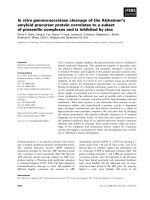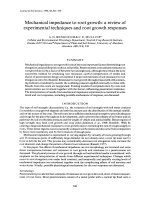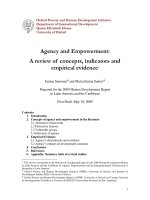Preview REACTIONS a collection of detailed mechanisms and synthetic applications. by JIE JACK LI (2020)
Bạn đang xem bản rút gọn của tài liệu. Xem và tải ngay bản đầy đủ của tài liệu tại đây (8.84 MB, 100 trang )
Buchwald–Hartwig amination Catellani reaction
JieChan–Lam
Jack Li coupling reaction
Dess–Martin oxidation Minisci reaction
Mitsunobu reaction
Negishi cross-coupling reaction Nicholas reaction
Nozaki–Hiyama–Kishi reaction
Overman rearrangement Petasis reaction
Name
Reactions
A Collection of Detailed Mechanisms
and Synthetic Applications
Sixth Edition
Name Reactions
Jie Jack Li
Name Reactions
A Collection of Detailed Mechanisms
and Synthetic Applications
Sixth Edition
Jie Jack Li, Ph.D
Discovery Chemistry
ChemPartner
San Francisco, CA, USA
ISBN 978-3-030-50864-7
ISBN 978-3-030-50865-4 (eBook)
/>© Springer Nature Switzerland AG 2021
This work is subject to copyright. All rights are reserved by the Publisher, whether the whole or part of
the material is concerned, specifically the rights of translation, reprinting, reuse of illustrations, recitation,
broadcasting, reproduction on microfilms or in any other physical way, and transmission or information
storage and retrieval, electronic adaptation, computer software, or by similar or dissimilar methodology
now known or hereafter developed.
The use of general descriptive names, registered names, trademarks, service marks, etc. in this publication
does not imply, even in the absence of a specific statement, that such names are exempt from the relevant
protective laws and regulations and therefore free for general use.
The publisher, the authors, and the editors are safe to assume that the advice and information in this book
are believed to be true and accurate at the date of publication. Neither the publisher nor the authors or
the editors give a warranty, expressed or implied, with respect to the material contained herein or for any
errors or omissions that may have been made. The publisher remains neutral with regard to jurisdictional
claims in published maps and institutional affiliations.
This Springer imprint is published by the registered company Springer Nature Switzerland AG.
The registered company address is: Gewerbestrasse 11, 6330 Cham, Switzerland
Dedicated to Prof. David R. Williams
Preface
Five years have elapsed since the fifth edition was published. Much has happened
since then. The author has migrated from academia back to industry. I have taken
out some name reactions from the fifth edition because the book was physically
getting too heavy and unwieldy. This change allows more space to expand and
update the more popular name reactions. All references have been updated to 2020
when available.
As in previous editions, each reaction is delineated by detailed, step-by-step,
electron-pushing mechanism, supplemented with the original and the latest references, especially review articles. Now, with addition of many synthetic applications, it is not only an indispensable resource for senior undergraduate and graduate students to learn mechanisms and synthetic utility of name reactions and to
prepare for their exams, but also a good reference book for all organic chemists in
both industry and academia.
As always, I welcome your critique. Please send your comments to this email
address:
March 1, 2020
San Mateo, California
Jie Jack Li
ix
Table of Contents
Preface ................................................................................................................... vii
Abbreviations ....................................................................................................... xv
Alder ene reaction ................................................................................................... 1
Aldol condensation .................................................................................................. 4
Arndt–Eistert homologation .................................................................................... 7
Baeyer–Villiger oxidation ..................................................................................... 10
Baker–Venkataraman rearrangement .................................................................... 13
Bamford–Stevens reaction..................................................................................... 16
Barbier reaction ..................................................................................................... 19
Barton–McCombie deoxygenation ........................................................................ 22
Beckmann rearrangement ...................................................................................... 25
Abnormal Beckmann rearrangement ............................................................. 28
Benzilic acid rearrangement .................................................................................. 29
Benzoin condensation ............................................................................................ 32
Bergman cyclization .............................................................................................. 35
Biginelli reaction ................................................................................................... 38
Birch reduction ...................................................................................................... 41
Bischler–Napieralski reaction ............................................................................... 44
Brook rearrangement ............................................................................................. 47
Brown hydroboration ............................................................................................ 50
Bucherer–Bergs reaction ....................................................................................... 53
Büchner ring expansion ......................................................................................... 56
Buchwald–Hartwig amination ............................................................................... 59
Burgess reagent ..................................................................................................... 64
Cadiot–Chodkiewicz coupling .............................................................................. 67
Cannizzaro reaction ............................................................................................... 70
Catellani reaction ................................................................................................... 73
Chan–Lam C–X coupling reaction ........................................................................ 77
Chapman rearrangement ........................................................................................ 81
xi
xii
Table of Contents
Chichibabin pyridine synthesis.............................................................................. 83
Chugaev reaction ................................................................................................... 86
Claisen condensation ............................................................................................. 89
Claisen rearrangement ........................................................................................... 91
para-Claisen rearrangement ........................................................................ 94
Abnormal Claisen rearrangement ................................................................. 97
Eschenmoser–Claisen amide acetal rearrangement .................................... 100
Ireland–Claisen (silyl ketene acetal) rearrangement ................................... 103
Johnson–Claisen (orthoester) rearrangement ............................................. 106
Clemmensen reduction ........................................................................................ 109
Cope elimination ................................................................................................. 112
Cope rearrangement ............................................................................................ 115
Anionic oxy-Cope rearrangement ............................................................... 118
Oxy-Cope rearrangement ............................................................................ 120
Siloxy-Cope rearrangement ......................................................................... 122
Corey–Bakshi–Shibata (CBS) reagent ................................................................ 124
CoreyChaykovsky reaction ............................................................................... 128
Corey–Fuchs reaction .......................................................................................... 131
Curtius rearrangement ......................................................................................... 134
Dakin oxidation ................................................................................................... 137
Dakin–West reaction ........................................................................................... 140
Darzens condensation .......................................................................................... 144
de Mayo reaction ................................................................................................. 147
Demjanov rearrangement .................................................................................... 151
Tiffeneau–Demjanov rearrangement ........................................................... 153
Dess–Martin oxidation ........................................................................................ 157
Dieckmann condensation .................................................................................... 162
Diels–Alder reaction ........................................................................................... 166
Hetero-Diels–Alder reaction ...................................................................... 170
Inverse electronic demand Diels–Alder reaction ......................................... 173
Dienone–phenol rearrangement........................................................................... 176
Dötz reaction ....................................................................................................... 179
Eschweiler–Clarke reductive amination .............................................................. 182
Favorskii rearrangement ...................................................................................... 186
quasi-Favorskii rearrangement .................................................................... 190
Ferrier carbocyclization ....................................................................................... 191
Ferrier glycal allylic rearrangement .................................................................... 194
Fischer indole synthesis....................................................................................... 197
Friedel–Crafts reaction ........................................................................................ 200
Friedel–Crafts acylation reaction ................................................................ 200
Friedel–Crafts alkylation reaction ............................................................... 204
Friedländer quinoline synthesis ........................................................................... 206
Fries rearrangement ............................................................................................. 209
Gabriel synthesis ................................................................................................. 212
Ing–Manske procedure ................................................................................ 216
Gewald aminothiophene synthesis ...................................................................... 218
Table of Contents
xiii
Glaser coupling.................................................................................................... 221
Eglinton coupling ........................................................................................ 224
Gould–Jacobs reaction......................................................................................... 228
Grignard reaction ................................................................................................. 231
Grob fragmentation ............................................................................................. 235
Hajos–Wiechert reaction ..................................................................................... 238
Hantzsch dihydropyridine synthesis .................................................................... 241
Heck reaction ....................................................................................................... 244
Henry nitroaldol reaction ..................................................................................... 248
Hiyama reaction .................................................................................................. 251
Hofmann elimination ........................................................................................... 254
Hofmann rearrangement ...................................................................................... 256
Hofmann–Löffler–Freytag reaction ..................................................................... 259
Horner–Wadsworth–Emmons reaction ............................................................... 262
Still–Gennari phosphonates ......................................................................... 265
Houben–Hoesch synthesis ................................................................................... 269
Hunsdiecker–Borodin reaction ............................................................................ 272
Jacobsen–Katsuki epoxidation ............................................................................ 275
Jones oxidation .................................................................................................... 279
Collins oxidation ......................................................................................... 283
PCC oxidation ............................................................................................. 284
PDC oxidation ............................................................................................. 286
Julia–Kocienski olefination ................................................................................. 288
Julia–Lythgoe olefination .................................................................................... 291
Knoevenagel condensation .................................................................................. 294
Knorr pyrazole synthesis ..................................................................................... 298
Koenig–Knorr glycosidation ............................................................................... 301
Krapcho reaction ................................................................................................. 305
Kröhnke pyridine synthesis ................................................................................. 307
Kumada cross-coupling reaction ......................................................................... 310
Lawessonʹs reagent .............................................................................................. 314
Leuckart–Wallach reaction .................................................................................. 317
Lossen rearrangement .......................................................................................... 320
McMurry coupling .............................................................................................. 323
Mannich reaction ................................................................................................. 326
Markovnikovʹs rule.............................................................................................. 329
Anti-Markovnikov ....................................................................................... 332
Martin’s sulfurane dehydrating reagent ............................................................... 335
Meerwein–Ponndorf–Verley reduction ............................................................... 339
Meisenheimer complex ....................................................................................... 342
Meyer–Schuster rearrangement ........................................................................... 345
Michael addition .................................................................................................. 348
Michaelis–Arbuzov phosphonate synthesis ......................................................... 352
Minisci reaction ................................................................................................... 354
Mitsunobu reaction .............................................................................................. 358
Miyaura borylation .............................................................................................. 362
xiv
Table of Contents
Morita–Baylis–Hillman reaction ......................................................................... 366
Mukaiyama aldol reaction ................................................................................... 370
Mukaiyama Michael addition .............................................................................. 373
Mukaiyama reagent ............................................................................................. 376
Nazarov cyclization ............................................................................................. 380
Neber rearrangement ........................................................................................... 383
Nef reaction ......................................................................................................... 386
Negishi cross-coupling reaction .......................................................................... 389
NewmanKwart reaction .................................................................................... 393
Nicholas reaction ................................................................................................. 396
Noyori asymmetric hydrogenation ...................................................................... 399
Nozaki–Hiyama–Kishi reaction .......................................................................... 403
Olefin metathesis ................................................................................................. 407
Oppenauer oxidation ........................................................................................... 412
Overman rearrangement ...................................................................................... 415
Paal–Knorr pyrrole synthesis .............................................................................. 418
Parham cyclization .............................................................................................. 421
Passerini reaction................................................................................................. 424
Paternò–Büchi reaction ....................................................................................... 427
Pauson–Khand reaction ....................................................................................... 430
Payne rearrangement ........................................................................................... 433
Petasis reaction .................................................................................................... 436
Peterson olefination ............................................................................................. 440
Pictet–Spengler tetrahydroisoquinoline synthesis ............................................... 443
Pinacol rearrangement ......................................................................................... 446
Pinner reaction..................................................................................................... 449
Polonovski reaction ............................................................................................. 452
Polonovski–Potier rearrangement ....................................................................... 455
Prins reaction ....................................................................................................... 458
Pummerer rearrangement .................................................................................... 462
Ramberg–Bäcklund reaction ............................................................................... 465
Reformatsky reaction .......................................................................................... 468
Ritter reaction ...................................................................................................... 471
Robinson annulation ............................................................................................ 474
Sandmeyer reaction ............................................................................................. 477
Schiemann reaction ............................................................................................. 480
Schmidt rearrangement........................................................................................ 483
Shapiro reaction................................................................................................... 486
Sharpless asymmetric amino hydroxylation ........................................................ 489
Sharpless asymmetric dihydroxylation ................................................................ 493
Sharpless asymmetric epoxidation ..................................................................... 497
Simmons–Smith reaction ................................................................................... 501
Smiles rearrangement .......................................................................................... 504
TruceSmile rearrangement ........................................................................ 507
Sommelet–Hauser rearrangement ....................................................................... 510
Sonogashira reaction ........................................................................................... 513
Table of Contents
xv
Stetter reaction ..................................................................................................... 516
Stevens rearrangement......................................................................................... 520
Stille coupling...................................................................................................... 523
Strecker amino acid synthesis ............................................................................. 527
Suzuki–Miyaura coupling ................................................................................... 530
Swern oxidation ................................................................................................... 533
Takai reaction ...................................................................................................... 536
Tebbe reagent ...................................................................................................... 540
Tsuji–Trost allylation .......................................................................................... 543
Ugi reaction ......................................................................................................... 547
Ullmann coupling ................................................................................................ 552
Vilsmeier–Haack reaction ................................................................................... 555
von Braun reaction .............................................................................................. 559
Wacker oxidation ................................................................................................ 561
Wagner–Meerwein rearrangement ...................................................................... 564
Williamson ether synthesis .................................................................................. 567
Wittig reaction ..................................................................................................... 570
[1,2]-Wittig rearrangement .......................................................................... 574
[2,3]-Wittig rearrangement .......................................................................... 577
Wolff rearrangement ........................................................................................... 580
Wolff–Kishner reduction ..................................................................................... 583
Subject Index ....................................................................................................... 586
Abbreviations and Acronyms
1,10-phen
3CC
3CR
4CC
9-BBN
A
Ac
acac
ACC
ADDP
AIBN
Alpine-borane®
AOM
Ar
ARA
ATH
ATPH
B:
BBEDA
bmim
BINAP
BINOL
Bn
Boc
BQ
BPR
BT
Bz
Polymer support
1,10-Phenanthroline
Three-component condensation
Three-component reaction
Four-component condensation
9-Borabicyclo[3.3.1]nonane
Adenosine
Acetyl
Acetylacetonate
Acetyl-CoA carboxylase
1,1′-(Azodicarbonyl)dipiperidine
2,2′-Azobisisobutyronitrile
B-Isopinocampheyl-9-borabicyclo[3.3.1]-nonane
p-Anisyloxymethyl = p-MeOC6H4OCH2Aryl
Asymmetric reductive amination
Asymmetric transfer hydrogenation
Tris(2,6-diphenyl)phenoxyaluminane
Generic base
Bis-benzylidene ethylenediamine
1-Butyl-3-methylimidazolium
2,2′-Bis(diphenylphosphino)-1,1′-binaphthyl
1,1ʹ-Bi-2-naphthaol
Benzyl
tert-Butyloxycarbonyl
Benzoquinone
Back pressure regulator
Benzothiazole
Benzoyl
xvii
xviii
CAN
CBS
Cbz
CCB
CD4
CDK
CFC
cod
COPC
Cp
CPME
CSA
CuTC
Cy
DABCO
dba
DBU
o-DCB
DCC
DCE
DDQ
de
DEAD
DEL
DET
(DHQ)2-PHAL
(DHQD)2-PHAL
DIAD
DIBAL
DIC
DIPT
DIPEA
DKR
DLP
DMA
DMAP
DME
DMF
DMFDMA
DMP
DMPU
DMS
DMSO
DMSY
DMT
Abbreviations and Acronyms
Cerium ammonium nitrate
Corey–Bakshi–Shibata reaction
Benzyloxycarbonyl
Calcium channel blockers
Cluster of differentiation 4
Cyclin-dependent kinase
Continuous flow centrifugation
1,5-Cyclooctadiene
Carbonyl–olefin [2 + 2] photocycloaddition
Cyclopentyl
Cyclopentyl methyl ether
Camphorsulfonic acid
Copper thiophene-2-carboxylate
Cyclohexyl
1,4-Diazabicyclo[2.2.2]octane
Dibenzylideneacetone
1,8-Diazabicyclo[5.4.0]undec-7-ene
ortho-Dichlorobenzene
1,3-Dicyclohexylcarbodiimide
Dichloroethane
2,3-Dichloro-5,6-dicyano-1,4-benzoquinone
Diastereoselctive excess
Diethyl azodicarboxylate
DNA-encoded library
Diethyl tartrate
Reaction heated under reflux
1,4-Bis(9-O-dihydroquinine)-phthalazine
1,4-Bis(9-O-dihydroquinidine)-phthalazine
Diisopropyl azodidicarboxylate
Diisobutylaluminum hydride
N,Nʹ-Diisopropylcarbodimide
Diisopropyl tartrate
Diisopropylethylamine
Dynamic kinetic resolution
Dilauroyl peroxide
N,N-dimethylacetamide
4-N,N-Dimethylaminopyridine
1,2-Dimethoxyethane
N,N-Dimethylformamide
N,N-Dimethylformamide dimethyl acetal
Dess–Martin periodinane
N,Nʹ-Dimethylpropyleneurea
Dimethylsulfide
Dimethylsulfoxide
Dimethylsulfoxonium methylide
Dimethoxytrityl
Abbreviations and Acronyms
DPP-4
DPPA
dppb
dppe
dppf
dppp
dr
DTBAD
DTBMP
DTBP
E1
E1cB
E2
EAN
EDCI
EDDA
EDG
EDTA
ee
Ei
EMC
ERK
Eq
Equiv
Et
EtOAc
EWG
FEP
Fmoc
fod
FVP
HCV
HFIP
HKR
HMDS
HMPA
HMTA
HMTTA
HOMO
IBDA
IBX
IDH1
IEDDA
Imd
xix
Dipeptidyl peptidase IV
Diphenylphosphoryl azide
1,4-Bis(diphenylphosphino)butane
1,2-Bis(diphenylphosphino)ethane
1,1′-Bis(diphenylphosphino)ferrocene
1,3-Bis(diphenylphosphino)propane
Diastereoselective ratio
Di-tert-butylazodicarbonate
2,6-Di-tert-butyl-4-methylpyridine
Di-tert-butyl peroxide
Unimolecular elimination
2-Step, base-induced -elimination via carbanion
Bimolecular elimination
Ethylammonium nitrate
1-Ethyl-3-(3-dimethylaminopropyl)carbodiimide
Ethylenediamine diacetate
Electron-donating group
Ethylenediaminetetraacetic acid
Enantiomeric excess
Two groups leave at about the same time and bond to
each other as they are doing so.
Meerwein–Eschenmoser–Claisen
Extracellular signal-regulated kinase
Equivalent
Equivalent
Ethyl
Ethyl acetate
Electron-withdrawing group
Fluorinated ethylene propene
Fluorenylmethyloxycarbonyl protecting group
1,1,1,2,2,3,3-heptafluoro-7,7-dimethyl-4,6octanedionate = Sieverʹs reagent
Flash vacuum pyrolysis
Hepatitis virus C
Hexafluoroisopropanol
Hydrolytic kinetic resolution
Hexamethyldisilazane
Hexamethylphosphoramide
Hexamethylenetetramine
1,1,4,7,10,10-Hexamethyltriethylenetetramine
Highest occupied molecular orbital
Iodosobenzene diacetate, also known as PIDA
o-Iodoxybenzoic acid
Isocitrate dehydrogenase 1
Inverse-electron-demand Diels–Alder
Imidazole
xx
IMDA
IPA
IPB
IPr
JAK
KHMDS
LAH
LDA
LED
LHMDS
LUMO
LTMP
M
MBI
m-CPBA
MCRs
Mes
Mincle
MLCT
MOM ether
MPL
MPM
MPS
Ms
MS
MWI
MTBE
MVK
NaDA
NBE
NBS
NCL
NCS
nbd
NBE
Nf
NFSI
NHC
NIS
NMM
NMO
NMP
Nos
NRI
N-PSP
N-PSS
Abbreviations and Acronyms
Intramolecular Diels–Alder reaction
Isopropyl alcohol (Indian pale ale)
Insoluble polymer bound
Diidopropyl-phenylimidazolium derivative
Janus kinase
Potassium hexamethyldisilazide
Lithium aluminum hydride
Lithium diisopropylamide
Light-emitting diode
Lithium hexamethyldisilazide
Lowest unoccupied molecular orbital
Lithium 2,2,6,6-tetramethylpiperidide
Metal
Mechanism-based inhibitors
m-Chloroperoxybenzoic acid
Multicomponent reactions
Mesityl
Macrophage-inducible C-type lectin
Metal to ligand charge transfer
Methoxymethyl ether
Medium pressure lamp
Methyl phenylmethyl
Morpholine-polysulfide
Methanesulfonyl (mesyl)
Molecular sieves
Microwave irradiation
Methyl tertiary butyl ether
Methyl vinyl ketone
Sodium diisopropylamide
Norbornene
N-Bromosuccinimide
Native chemical ligation
N-Chlorosuccinimide
2,5-Norbornadiene
Norbornene
Nonafluorobutanesulfonyl
N-Fluorobenzenesulfonimide
N-Heterocyclic carbene
N-Iodosuccinimide
N-Methyl morpholine
N-Methylmorpholine N-oxide (NMMO)
1-Methyl-2-pyrrolidinone
Nosylate = 4-nitrobenzenesulfonyl = Ns
Noradrenaline reuptake inhibitor
N-Phenylselenophthalimide
N-Phenylselenosuccinimide
Abbreviations and Acronyms
Nu
Nuc
Ns
PAR-1
PARP
PCC
PDC
PDI
PE
PEG
PEPPSI
phen
PIDA
Pin
Piv
PNB
PMB
PPA
PPSE
PPTS
PT
PTADS
PTSA
PyPh2P
Pyr
rac
Red-Al
rr
Salen
SET
SIBX
SM
SMC
SMEAH
SN1
SN2
SNAr
SSRI
T3P
TBABB
TBAF
TBAI
TBAO
xxi
Nucleophile
Nucleophile
Nosylate
Protease activated receptor-1
Poly(ADP-ribosyl) polymerase
Pyridinium chlorochromate
Pyridinium dichromate
Phosphinyl dipeptide isostere
Premature ejaculation
Polyethylene glycol
Pyridine-enhanced pre-catalyst preparation,
stabilization, and initiation
1,10-Phenanthroline
Phenyliodine diacetate (same as IBDA)
Pinacol
Pivaloyl
p-Nitrobenzyl
para-Methoxybenzyl
Polyphosphoric acid
Trimethylsilyl polyphosphate
Pyridinium p-toluenesulfonate
Phenyltetrazolyl
Tetrakis[(R)-(+)-N-(p-dodecylphenylsulfonyl)prolinato]
p-Toluenesulfonic acid
Diphenyl 2-pyridylphosphine
Pyridine
Racemic
Sodium bis(methoxy-ethoxy)aluminum hydride
(SMEAH)
regioisomeric ratio
N,Nʹ-Disalicylidene-ethylenediamine
Single-electron transfer
Stabilized IBX
Starting material
Sodium methyl carbonate
Sodium bis(methoxy-ethoxy)aluminum hydride:
trade name Red-Al
Unimolecular nucleophilic substitution
Bimolecular nucleophilic substitution
Nucleophilic substitution on an aromatic ring
Selective serotonin reuptake inhibitor
Propylphosphonic anhydride
Tetra-n-butylammonium bibenzoate
Tetra-n-butylammonium fluoride
Tetra-n-butylammonium iodide
1,3,3-Trimethyl-6-azabicyclo[3.2.1]octane
xxii
TBDMS
TBDPS
TBHP
TBS
t-Bu
TDI
TDS
TEA
TEMPO
TEOC
TES
Tf
TFA
TFAA
TFE
TFEA
THF
TFP
TFPAA
TIPS
TMEDA
TMG
TMOF
TMP
TMS
TMSCl
TMSCN
TMSI
TMSOTf
TMU
Tol
Tol-BINAP
TosMIC
TPPO
TrxR
Ts
TsO
TTBP
UHP
VAPOL
VMR
WERSA
Abbreviations and Acronyms
tert-Butyldimethylsilyl
tert-Butyldiphenylsilyl
tert-Butyl hydroperoxide
tert-Butyldimethylsilyl
tert-Butyl
Thiophosphinyl dipeptide isostere
Thexyldimethylsilyl
Triethylamine
2,2,6,6-Tetramethylpiperidinyloxy
Trimethysilylethoxycarbonyl
Triethylsilyl
Trifluoromethanesulfonyl (triflate)
Trifluoroacetic acid
Trifluoroacetic anhydride
Trifluoroethanol
Trifluoroethyl trifluoroacetate
Tetrahydrofuran
Tri-2-furylphosphine
Trifluoroperacetic acid
Triisopropylsilyl
N,N,N′,N′-Tetramethylethylenediamine
1,1,3,3-Tetramethylguanidine
Trimethyl orthoformate
Tetramethylpiperidine
Trimethylsilyl
Trimethylsilyl chloride
Trimethylsilyl cyanide
Trimethylsilyl iodide
Trimethylsilyl triflate
Tetramethylurea
Toluene or tolyl
2,2′-Bis(di-p-tolylphosphino)-1,1′-binaphthyl
(p-Tolylsulfonyl)methyl isocyanide
Triphenylphosphine oxide
Thioredoxin reductase
Tosyl
Tosylate
2,4,6-Tri-tert-butylpyrimidine
Urea-hydrogen peroxide
2,2′-Diphenyl-(4-biphen-anthrol)
Vinylogous Mannich reaction
Water extract of rice straw ash
Jie Jack Li
1
Alder Ene Reaction
The Alder ene reaction, also known as the hydro-allyl addition, is addition of an
enophile to an alkene (ene) via allylic transposition. The four-electron system including an alkene π-bond and an allylic C–H σ-bond can participate in a pericyclic
reaction in which the double bond shifts and new C–H and C–C σ-bonds are
formed.
X=Y: C=C, C≡C, C=O, C=N, N=N, N=O, S=O, etc.
Example 15
Example 2, Here the “ene” is a carbonyl of the aldehyde7
© Springer Nature Switzerland AG 2021
J. J. Li, Name Reactions, />
2
Name Reactions
Example 3, Intramolecular Alder ene reaction8
Example 4, Cobalt-catalyzed Alder ene reaction9
Example 5, Nitrile-migrating Alder ene reaction10
Example 611
Example 713
Example 8, Pd-catalyzed intramolecular Alder ene (BBEDA = bis-benzylidene
ethylenediamine)14
Jie Jack Li
3
Example 9, Alder ene driven by high steric strain and bond angle distortion15
References
1.
2.
3.
4.
5.
6.
7.
8.
9.
10.
11.
12.
13.
14.
15.
16.
Alder, K.; Pascher, F.; Schmitz, A. Ber. 1943, 76, 2753. Kurt Alder (Germany,
19021958) shared the Nobel Prize in Chemistry in 1950 with his teacher Otto Diels
(Germany, 18761954) for the development of the diene synthesis.
Oppolzer, W. Pure Appl. Chem. 1981, 53, 11811201. (Review).
Johnson, J. S.; Evans, D. A. Acc. Chem. Res. 2000, 33, 325335. (Review).
Mikami, K.; Nakai, T. In Catalytic Asymmetric Synthesis; 2nd edn.; Ojima, I., ed.;
WileyVCH: New York, 2000, 543568. (Review).
Sulikowski, G. A.; Sulikowski, M. M. e-EROS Encyclopedia of Reagents for Organic
Synthesis 2001, Wiley: Chichester, UK.
Brummond, K. M.; McCabe, J. M. The Rhodium(I)-Catalyzed Alder ene Reaction. In
Modern Rhodium-Catalyzed Organic Reactions 2005, 151172. (Review).
Miles, W. H.; Dethoff, E. A.; Tuson, H. H.; Ulas, G. J. Org. Chem. 2005, 70,
28622865.
Pedrosa, R.; Andres, C.; Martin, L.; Nieto, J.; Roson, C. J. Org. Chem. 2005, 70,
43324337.
Hilt, G.; Treutwein, J. Angew. Chem. Int. Ed. 2007, 46, 85008502.
Ashirov, R. V.; Shamov, G. A.; Lodochnikova, O. A.; Litvynov, I. A.; Appolonova, S.
A.; Plemenkov, V. V. J. Org. Chem. 2008, 73, 59855988.
Cho, E. J.; Lee, D. Org. Lett. 2008, 10, 257259.
Curran, T. T. Alder Ene Reaction. In Name Reactions for Homologations-Part II; Li, J.
J., Ed.; Wiley: Hoboken, NJ, 2009, pp 232. (Review).
Trost, B. M.; Quintard, A. Org. Lett. 2012, 14, 46984670.
Nugent, J.; Matousova, E.; Banwell, M. G.; Willis, A. C. J. Org. Chem. 2017, 82,
1256912589.
Gupta, S.; Lin, Y.; Xia, Y.; Wink, D. J.; Lee, D. Chem. Sci. 2019, 10, 22122217.
Imino-ene reaction: Hou, L.; Kang, T.; Yang, L.; Cao, W.; Feng, X. Org. Lett. 2020,
22, 13901395.
4
Name Reactions
Aldol Condensation
The aldol condensation is the coupling of an enolate ion with a carbonyl compound to form a β-hydroxycarbonyl, and sometimes, followed by dehydration to
give a conjugated enone. A simple case is addition of an enolate to an aldehyde to
afford an alcohol, thus the name aldol.
Example 13
Example 28
© Springer Nature Switzerland AG 2021
J. J. Li, Name Reactions, />
Jie Jack Li
Example 3, Enantioselective Mukaiyama aldol reaction10
Example 4, Intermolecular aldol reaction using organocatalyst12
Example 5, Intramolecular aldol reaction13
Example 6, Intramolecular vinylogous aldol reaction [ATPH = tris(2,6diphenyl)phenoxyaluminane]14
Example 7, A rare stereospecific retroaldol reaction15
5
Name Reactions
6
Example 8, A rare intermolecular vinylogous aldol reaction, TFE = trifluoroethanol16
References
1.
2.
3.
4.
5.
6.
7.
8.
9.
10.
11.
12.
13.
14.
15.
16.
17.
Wurtz, C. A. Bull. Soc. Chim. Fr. 1872, 17, 436442. Charles Adolphe Wurtz
(18171884) was born in Strasbourg, France. After his doctoral training, he spent a
year under Liebig in 1843. In 1874, Wurtz became the Chair of Organic Chemistry at
the Sorbonne, where he educated many illustrous chemists such as Crafts, Fittig,
Friedel, and van’t Hoff. The Wurtz reaction, where two alkyl halides are treated with
sodium to form a new carboncarbon bond, is no longer considered synthetically
useful, although the aldol reaction that Wurtz discovered in 1872 has become a staple
in organic synthesis. Alexander P. Borodin is also credited with the discovery of the
aldol reaction together with Wurtz. In 1872 he announced to the Russian Chemical
Society the discovery of a new by-product in aldehyde reactions with properties like
that of an alcohol, and he noted similarities with compounds already discussed in publications by Wurtz from the same year.
Nielsen, A. T.; Houlihan, W. J. Org. React. 1968, 16, 1438. (Review).
Still, W. C.; McDonald, J. H., III. Tetrahedron Lett. 1980, 21, 10311034.
Mukaiyama, T. Org. React. 1982, 28, 203331. (Review).
Mukaiyama, T.; Kobayashi, S. Org. React. 1994, 46, 1103. (Review on tin(II) enolates).
Johnson, J. S.; Evans, D. A. Acc. Chem. Res. 2000, 33, 325335. (Review).
Denmark, S. E.; Stavenger, R. A. Acc. Chem. Res. 2000, 33, 432440. (Review).
Yang, Z.; He, Y.; Vourloumis, D.; Vallberg, H.; Nicolaou, K. C. Angew. Chem. Int.
Ed. 1997, 36, 166168.
Mahrwald, R. (ed.) Modern Aldol Reactions, WileyVCH: Weinheim, Germany,
2004. (Book).
Desimoni, G.; Faita, G.; Piccinini, F. Eur. J. Org. Chem. 2006, 52285230.
Guillena, G.; Najera, C.; Ramon, D. J. Tetrahedron: Asymmetry 2007, 18, 22492293.
(Review on enantioselective direct aldol reaction using organocatalysis.)
Doherty, S.; Knight, J. G.; McRae, A.; Harrington, R. W.; Clegg, W. Eur. J. Org.
Chem. 2008, 17591766.
O’Brien, E. M.; Morgan, B. J.; Kozlowski, M. C. Angew. Chem. Int. Ed. 2008, 47,
68776880.
Gazaille, J. A.; Abramite, J. A.; Sammakia, T. Org. Lett. 2012, 14, 178181.
Wang, J.; Deng, Z.-X.; Wang, C.-M.; Xia, P.-J.; Xiao, J.-A.; Xiang, H.-Y.; Chen, X.Q.; Yang, H. Org. Lett. 2018, 20, 75357538.
Kutwal, M. S.; Dev, S.; Appayee, C. Org. Lett. 2019, 21, 25092513.
Vojackova, P.; Michalska, L.; Necas, M.; Shcherbakov, D.; Bottger, E. C.; Sponer, J.;
Sponer, J. E.; Svenda, J. J. Am. Chem. Soc. 2020, 142, 73067311.









